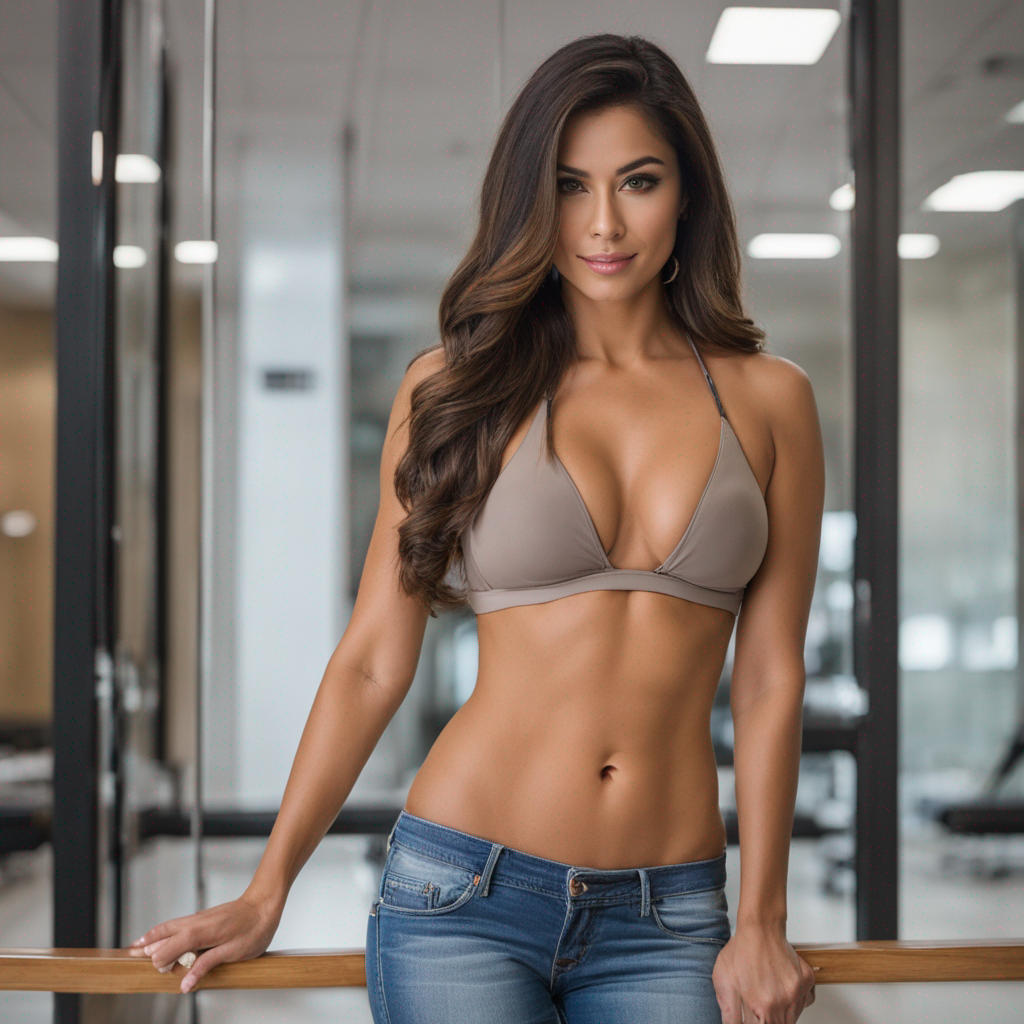Empower Your Body: The Ultimate Guide to Female Fitness and Sculpting
Posted on: December 18, 2023
Female bodybuilding and sculpting has carved its niche in the fitness world, stepping beyond the boundaries of generic weight loss to offer a targeted workout plan for reshaping the physique, including skin tightening and breast enhancement. Once reserved for celebrities and athletes, this tailored bodybuilding practice now empowers female bodybuilders everywhere to sculpt their bodies with precision, focusing on specific areas like the breast or bikini-ready skin through a dedicated workout plan. As societal norms shift towards celebrating strength over size, an increasing number of women, including female bodybuilders, are turning to bodybuilding and skin tightening techniques to enhance their natural contours, including the breast area, and boost confidence.
The allure of bodybuilding lies in its promise of physique transformation without a one-size-fits-all regimen, appealing to both male and female bodybuilder enthusiasts seeking skin tightening benefits. It’s about sculpting the physique part by part, achieving bodybuilding harmony and proportion with skin tightening that aligns with personal beauty standards. This modern alchemy of bodybuilding blends artistry with anatomy, sculpting each physique and body part into a statement of individual empowerment, while the skin reflects the culmination of this transformative journey.
Understanding the Fundamentals of Bodybuilding
Muscle hypertrophy and resistance training are essential in bodybuilding, differing significantly between genders, impacting men’s physique, size, and skin.
Muscle Hypertrophy Importance
Muscle growth, or hypertrophy, is key to body sculpting. It’s how muscles increase in size.
For female bodybuilders, it’s about achieving a toned look rather than the bulkiness often associated with men in bodybuilding, while also maintaining healthy skin every day. The process involves more than just lifting weights. Bodybuilding requires a detailed plan that balances exercise with recovery, ensuring men maintain healthy skin day by day.
Resistance Training Role
Resistance training is the engine driving muscle development. Bodybuilding challenges your muscles and skin, causing them to adapt and grow stronger over each day.
Women often focus on high-rep bodybuilding workouts to shape their bodies and improve skin, day by day. This bodybuilding approach helps maintain lean muscle mass while promoting fat loss and skin health. Consistent training leads to impressive results for female athletes.
Male vs Female Physiology
Men and women have different bodybuilding journeys due to physiology, including variations in skin. In bodybuilding, hormones like testosterone play a big part in this difference.
Women generally have less muscle mass and more fat tissue naturally, which can be a consideration in bodybuilding. Their muscle growth in bodybuilding tends to be slower compared to men’s but can be equally defined with proper training.
Weekly Workout Routines for Women’s Body Sculpting
Creating a balanced workout schedule is crucial for effective body sculpting and bodybuilding. Consistency in bodybuilding and recovery are key to achieving the desired results.
Sample Schedule
A well-rounded routine combines strength training with cardio. Here’s a sample weekly plan:
- Monday: Start the week with full-body strength training. Aim for 12-15 reps per exercise.
- Tuesday: Cardio day. Incorporate a brisk 30-minute run or cycling session into your bodybuilding routine.
- Wednesday: Focus on lower-body strength. Squats and lunges are great choices.
- Thursday: Take this as an active recovery day. A gentle yoga session can work wonders.
- Friday: Upper-body strength day. Include exercises like push-ups and dumbbell presses.
- Saturday: High-intensity interval training (HIIT) for a quick, intense cardio workout, complementing your bodybuilding regimen.
- Sunday: Rest day to allow your bodybuilding muscles to recover fully.
Intensity and Recovery
Balancing hard workouts with rest is essential:
- Alternate between high-intensity days and moderate activities.
- Incorporate stretching or foam rolling after each workout.
This balance in bodybuilding helps prevent injuries and ensures that you’re always ready for the next training session.
Consistent Routines
Sticking to your plan is vital:
- Set specific days and times for workouts.
- Track your bodybuilding progress in a journal or app to stay motivated.
Consistency leads to better performance, muscle memory, and long-term success in body sculpting goals.
Strategies for Toning and Sculpting the Female Physique
The journey to a sculpted physique involves targeted exercises that tone muscles and burn fat. Compound movements, HIIT, and core exercises are key.
Compound Movements Benefit
Compound movements engage multiple muscle groups at once. This efficiency means you work more of your body in less time. Think squats, deadlifts, and bench presses. These exercises help tone your legs, back, and chest all together.
For example, when lifting weights during a squat, not only do your quadriceps work hard, but so do your glutes, hamstrings, and even your core. This full-body approach ensures balanced toning and strength gains.
HIIT for Fat Loss
High-intensity interval training (HIIT) is a powerful tool for fat loss. It alternates short bursts of intense activity with periods of rest or low-intensity exercise. A 20-minute HIIT session can burn more calories than a steady-state cardio workout lasting twice as long.
This method boosts metabolism even after you’ve finished exercising. Studies show that participants continue to burn calories hours after a HIIT workout due to the increased oxygen consumption required to recover from the intense effort.
Core Strengthening Essential
A strong core is vital for overall body sculpting. It’s not just about flat abs; it’s about stability and power in every exercise you do. Planks, Russian twists, and leg raises target this central part of your physique.
By strengthening the core muscles—like the abdominals and lower back—you improve posture and reduce the risk of injuries during other exercises or daily activities.
Nutritional Plans Tailored for Female Bodybuilders
After exploring strategies for toning and sculpting, it’s crucial to understand the nutritional aspect. Proper diet is key for female bodybuilders looking to build muscle and recover efficiently.
Macronutrient Ratios
For optimal muscle growth, female bodybuilders need a balanced diet rich in macronutrients. Proteins are the building blocks of muscles. A high protein intake is essential for repair and growth. Carbohydrates provide the energy needed during workouts. Fats are important too; they support hormone health, which is vital for muscle development.
A common macronutrient ratio might look like this:
- 40-50% Carbohydrates
- 30-35% Protein
- 20-30% Fats
These percentages can vary based on individual goals and bodies.
Meal Timing Importance
Eating at the right time boosts performance and recovery. Meals before working out should fuel your body with energy. This usually means a mix of carbs and proteins an hour or two before exercise.
Post-workout meals aid in recovery. They should be eaten within 45 minutes after exercising to maximize muscle repair. Think about including plenty of proteins and some carbs to replenish glycogen stores.
Hydration Role
Muscles need water to function well and recover after strain. Dehydration can lead to poor performance, fatigue, and even injury. Female bodybuilders should focus on staying hydrated throughout the day, not just during workouts.
Role of Weight Training and Protein in Women’s Fitness
Weight training and protein intake are pivotal in women’s fitness, affecting bone health and muscle growth. Myths around weightlifting causing bulkiness in women need to be addressed for a clearer understanding.
Weightlifting Boosts Bone Density
Strength training is not just about building muscle; it has profound effects on bone density. As you lift weights, the stress on your bones signals them to strengthen. This process can help fend off osteoporosis, a condition where bones become brittle and fragile.
Women often experience a decline in bone density as they age. Incorporating weight-bearing exercises can slow down or even reverse this trend. Studies show that regular strength training increases bone mineral density, providing a sturdy skeletal framework.
Metabolism Gets Revved Up
Your body’s metabolism determines how many calories you burn at rest. Muscle tissue is more metabolically active than fat tissue. So, the more muscle you have, the higher your resting metabolic rate will be.
Weight training helps build lean muscle mass which boosts your metabolism throughout the day. Even when you’re not working out, your body continues to burn calories at an elevated rate. This makes maintaining a healthy weight or losing excess pounds easier for women who engage in regular strength training.
Protein Powers Muscle Repair
After discussing nutritional plans tailored for female bodybuilders, it’s crucial to understand protein’s role in fitness. Protein isn’t just fuel; it’s the building block of muscles. When you engage in female body sculpting through strength training, muscles experience tiny tears that need repairing.

The recommended daily protein intake varies depending on activity level but generally falls between 1.2-2 grams per kilogram of body weight for those involved in rigorous physical activities like weightlifting.
Eating enough protein ensures that your muscles repair and grow stronger post-workout. It supports endurance and aids recovery, making it essential for any woman focused on fitness and body sculpting.
Busting Bulkiness Myths
Many women shy away from weightlifting due to fears of becoming too bulky. However, this is a myth that needs debunking for good!
Women typically have lower levels of testosterone compared to men, making it harder to gain large amounts of muscle mass quickly. Strength training leads to toned muscles and improved shape rather than bulkiness.
Targeted Workout Plans for Glutes and Legs
Building strong glutes and shapely legs is a goal for many women. A targeted workout plan can help achieve this without adding unwanted bulk.
Glute Activation Exercises
To sculpt the female body, particularly the glutes, it’s essential to activate these muscles before heavier lifting. This can be done through exercises such as:
- Bridges
- Clamshells
- Donkey kicks
These moves focus on firing up the glute muscles, which is crucial for strength and shape. They should be part of your routine two to three times per week.
Strength-Building Squats
Squats are a powerhouse move for targeting the lower body. But not all squats are created equal. Here’s how you can use squats smartly:
- Opt for moderate weights that challenge you without straining.
- Focus on form to engage glutes properly.
- Incorporate variations like sumo squats or split squats.
By doing this, you work on strength without unnecessarily bulking up the thighs.
Leg Shaping Workouts
Leg workouts that enhance shape involve more than just heavy lifting. Consider these strategies:
- Use resistance bands for lateral walks or leg lifts.
- Include plyometric exercises like jump squats or lunges. Remember, shaping your legs isn’t just about what exercises you do; it’s also about how you do them.
Optimal Training Frequency
The frequency of your leg and glute workouts plays a significant role in achieving results. Here’s what to keep in mind:
- Aim for 2–3 sessions per week focused on these areas.
- Allow rest days in between to let muscles recover and grow. Tracking progress over time will help adjust frequency for continued improvement.
Non-Invasive Fat Reduction and Contouring Procedures
Non-invasive treatments for body sculpting have gained popularity. These procedures offer fat reduction without surgery.
Popular Non-Invasive Treatments
CoolSculpting stands out among non-invasive fat reduction methods. It uses cold temperatures to freeze and eliminate fat cells. Another treatment, SculpSure, harnesses laser technology to heat and destroy fat. Both promise skin tightening effects as well.
These treatments target stubborn areas. Think love handles or belly fat that workouts can’t easily fix.
Workout vs Procedure Results
Traditional workouts improve overall health. They also enhance muscle tone and endurance. But they might not always conquer stubborn fat pockets.
In contrast, CoolSculpting and SculpSure can specifically target these trouble spots. Result times vary but often show within weeks.
Imagine a sculptor chiseling away at marble; that’s how precise these procedures can be compared to the broad strokes of exercise.
Safety in Cosmetic Fat Reduction
Safety is crucial when considering cosmetic procedures for female body sculpting. Both CoolSculpting and SculpSure are FDA-approved, indicating a level of safety for general use.
However, potential side effects exist with any cosmetic procedure. Common ones include temporary redness, swelling, or tenderness at the treatment site.
It’s essential to consult healthcare professionals before deciding on a procedure. They can provide personalized advice based on individual health profiles.
Augmentation Alternatives
While reducing unwanted fat is one goal, some seek augmentation or enhancement in specific areas like the buttocks or breasts.
Fat transfer is a technique where fat from one area is moved to another for natural augmentation. This method doubles as both reduction and enhancement without foreign implants.
The results are dual: reduced volume where desired and increased fullness where needed.
Setting Realistic Expectations from Body Sculpting Sessions
Body sculpting is a journey, not an overnight miracle. Visible changes and final results depend on various factors like genetics and lifestyle.
Visible Changes Timeline
The path to reshaping your body is unique for everyone. Initially, changes may seem slow. But with consistent training, you might start noticing differences in as little as a few weeks. However, significant transformations often take months or even years.
For example, someone might notice their clothes fitting better within the first month of strength training and cardio. Yet, another person could be working out just as hard without seeing such quick results.
Individual Results Factors
Why do results vary so much? Genetics play a huge role in how our bodies respond to exercise. Some people build muscle quickly; others may find it more challenging due to their genetic makeup.
Age also influences outcomes. Younger individuals tend to see faster results due to higher metabolism rates and recovery capabilities. But that doesn’t mean older adults can’t achieve amazing transformations—they might just need more time.
Consider these factors:
- Metabolism speed
- Muscle fiber type distribution
- Hormonal balance
- Previous fitness levels
Patience and Perseverance
Patience is crucial in body sculpting. Quick fixes don’t exist; it’s about long-term commitment. Celebrate small victories along the way—each one brings you closer to your goal.
Perseverance is equally important. You will face plateaus and challenges, but pushing through them is part of the process. Remember why you started and keep moving forward.
Long-Term Muscle Building and Fat Loss Strategies
After understanding realistic expectations, it’s vital to focus on long-term strategies for muscle building and fat loss. Sustainable dieting and workout adjustments, along with rest and stress management, are key.
Sustainable Diet Practices
To support muscle growth over time, your diet is crucial. It’s not just about eating more; it’s about eating right.
Incorporate a variety of proteins, carbs, and fats to fuel your muscles. Lean meats, legumes, whole grains, and healthy fats should be staples. Eating enough protein is essential for repairing and building muscle fibers. But don’t forget the importance of vitamins and minerals from fruits and vegetables.
Stay hydrated too! Water plays a big part in metabolic processes that contribute to hypertrophy (muscle growth). Remember to adjust your calorie intake as you progress. Your body’s needs change as you gain muscle mass.
Workout Plan Adjustments
Avoid hitting a plateau by changing up your routine. If you’ve been doing the same exercises for weeks, it’s time to switch gears.
Focus on different muscle groups each session. This allows some muscles to recover while others work hard. Try new types of workouts like HIIT or Pilates for variety.
Increase the weight or resistance gradually. This encourages continuous muscle growth without overwhelming your body.
Incorporate both compound movements (like squats) and isolation exercises (like bicep curls). This ensures all parts of a muscle group get attention.
Rest and Stress Management
Rest isn’t just sleep—it’s also taking breaks between workouts. Your muscles need time to repair after being stressed during exercise.
Get quality sleep every night; aim for 7-9 hours if possible. Good sleep supports recovery processes critical for gaining muscle mass.
Manage stress through practices like meditation or yoga. High stress can hinder muscle recovery due to increased cortisol levels in the body.
Take at least one full rest day per week away from intense physical activity—your muscles will thank you!
Conclusion
Embarking on a body sculpting journey is like crafting a masterpiece—your dedication shapes the outcome. We’ve explored the essentials, from workout routines to nutrition plans, and highlighted how weight training and protein are your fitness allies. With targeted exercises for glutes and legs, plus non-invasive contouring options, you’re equipped to chisel your physique. But remember, real beauty is sculpted over time; patience and persistence are your chisels.
Now it’s your turn to lift, tone, and transform. Set goals that spark your spirit and pursue them with grit. Your body is your canvas; paint it strong, confident, and uniquely yours. Ready to flex your potential? Grab those weights and carve out your success story—one rep at a time. Let’s get sculpting!
Frequently Asked Questions
What is female body sculpting?
Female body sculpting involves targeted exercises and nutrition plans to tone muscles, reduce fat, and shape the body aesthetically.





